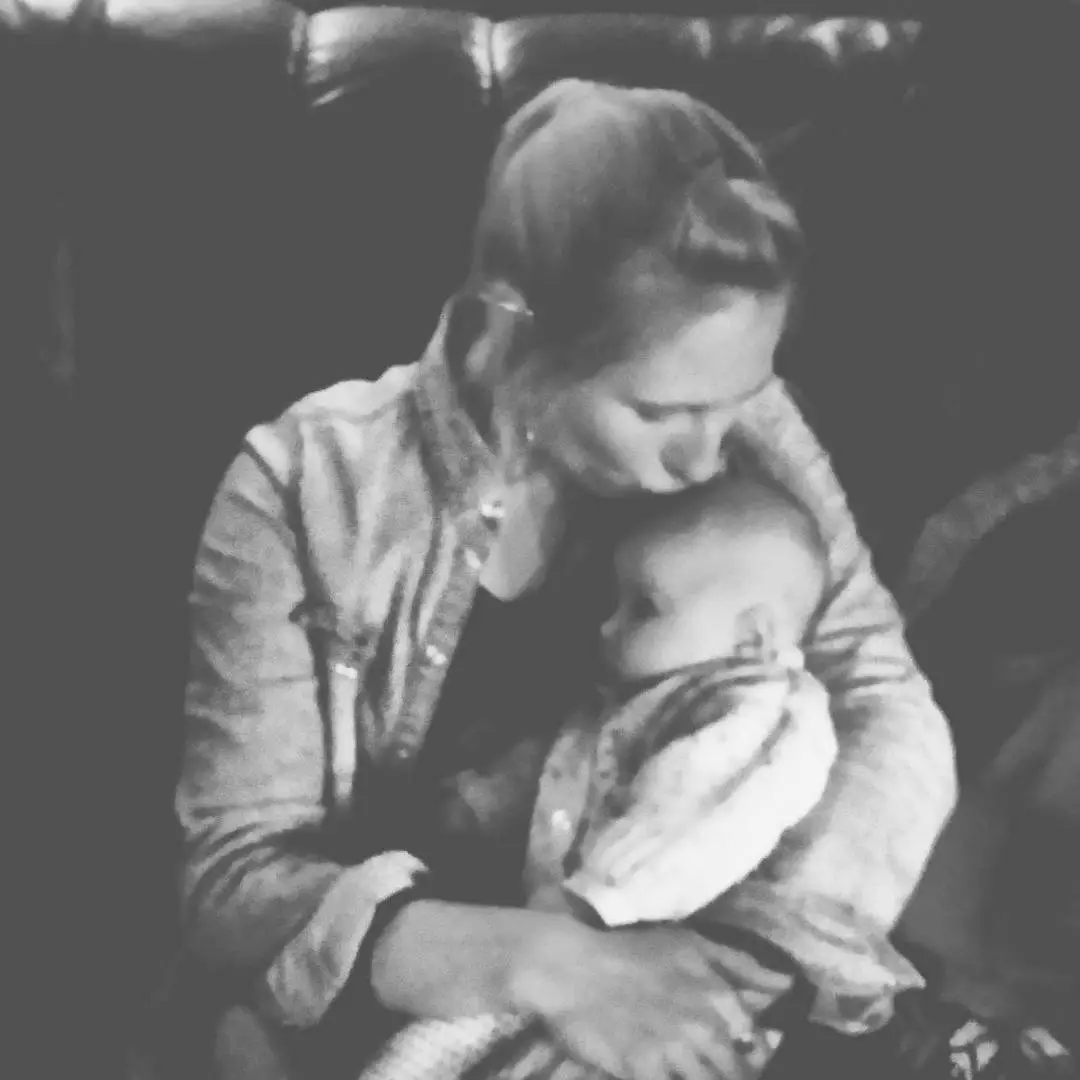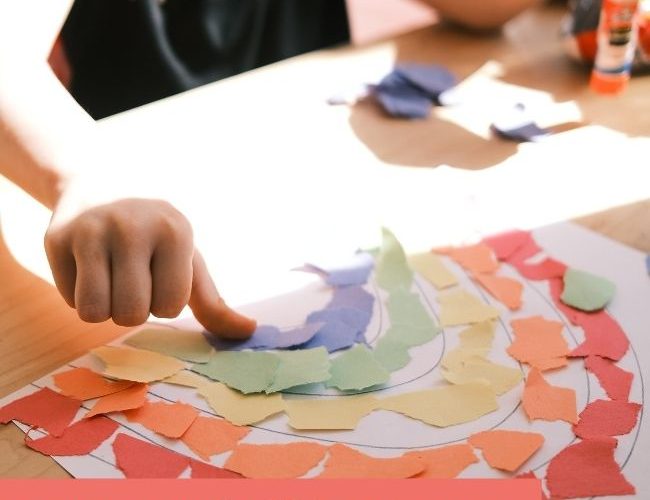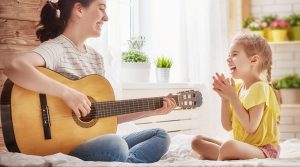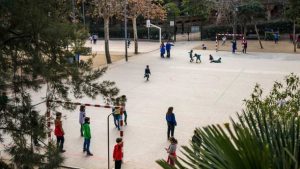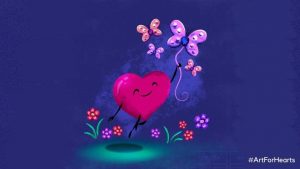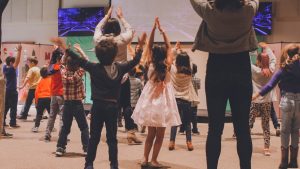Naturally creative and ambitious, many kids take to the arts like fish to water, quickly finding a niche and evolving their skills.
Others simply enjoy the self-expression found at the arts and crafts table, achieving mindfulness and finding self-esteem in the act of creating something of their own.
Creating art doesn’t just feel good, it does good. Science has linked the arts with numerous physical, social, and cognitive benefits for kids, so the time they spend singing, dancing, painting, drawing, acting, and engaging in other creative activities, actively contributes to their whole-child development.
Let’s dive in!
The Infographic

The Arts and child development: examining the evidence
This collection of 12 studies connects art, music, drama, and creative movement with physical, cognitive, creative, and social benefits which may positively impact child development.

Imagination, creativity, and experimentation
1. Encourages self-expression through creative storytelling
Storytelling play offers children a unique opportunity to share their thoughts, feelings, and perspectives, inspiring them to express them in a creative, meaningful way.
One of the reasons that roleplay is an important part of child development is that kids express themselves and learn to process and regulate emotions through dramatic play.
In Goodman’s naturalistic study of the relationship between dramatic play and literacy development, theatre-style play was identified as a source of creative motivation.
When children act out their stories during dramatic theatre-style play, they use imagination, creativity, and self-expression in the creation of their narratives.
Key study/paper: Goodman, Jennifer Ross. “A naturalistic study of the relationship between literacy development and dramatic play in five-year-old children.” Unpublished EdD dissertation. Nashville, TN: George Peabody College for Teachers, Vanderbilt University (1990).
Source: artsedsearch.org/study/naturalistic-study/
2. Increases arts engagement in young ddulthood
Remaining in arts education throughout primary and secondary school can provide numerous benefits for children, including greater academic achievement, higher self-esteem, and improved critical-thinking skills, among others.
An early start in the arts can impact the level to which older kids and teens engage with arts education. When young children are given opportunities to participate in the arts, their interest is likely to carry over into their scholastic career.
Longitudinal studies have discovered that participation in the arts during early childhood is a predictor of greater arts education engagement during primary and secondary school.
Key study/paper: Foster, E. Michael, and Jade V. Marcus Jenkins. “Does participation in music and performing arts influence child development?.” American Educational Research Journal 54.3 (2017): 399-443.
Source: journals.sagepub.com/doi/abs/

Social interaction
3. Boosts self esteem
Developing and maintaining healthy self-esteem can be a challenge for some kids, as fitting in socially, keeping up with academics, and coping with growing up can all impact a child’s self-image.
Finding hobbies that keep them engaged and focused on self-development can help to mitigate some of those negative self-views.
Disadvantaged children, who may lack the role models and structure necessary to reinforce strong self-esteem, are particularly likely to benefit from engaging with the arts.
In a study measuring the effects of music performance and therapy on efficacy and self-esteem, a group of disadvantaged teens taking guitar lessons demonstrated marked improvements in self-esteem and efficacy after four months of training.
Key study/paper: Kennedy, Roy. The effects of musical performance, rational emotive therapy, and vicarious experience on the self-efficacy and self-esteem of juvenile delinquents and disadvantaged children. Diss. University of Kansas, Music and Dance, 1998.
Source: artsedsearch.org/study/the-effects-of-musical-performance
4. Raises confidence and tolerance of others
Treating others with tolerance is an important lesson, and one that’s best learned early.
Engaging with different kinds of people, and in different settings, helps kids create a broader “normal” that acknowledges the experiences and voices of people from ethnicities, sexualities, and classes other than their own.
Engagement with the arts is another way that children can become more confident in themselves and more tolerant of others.
Adolescent participation in dance education has been linked with significant improvements in a child’s confidence, tolerance, and persistence.
Key study/paper: Ross, Janice. “Art and community: Creating knowledge through service in dance.” Comunicació presentada American Educational Research Association, New Orleans. Recuperat de: www. artsedsearch. org/summaries/art-and-community-creating-knowledge-through-servicein-dance (2000).
Source: artsedsearch.org/study/art-and-community

Expressive qualities
5. Greater likelihood of ongoing participation in creative arts
Artistic hobbies can become productive, meditative, and even lucrative, the passion that fuels them often beginning with early childhood engagement with the arts.
When children get to experience art, music, and dance, they can develop a lifelong interest that will contribute to their well-being in numerous ways.
A study assessing the correlation between participation in music and the performing arts with child development opportunities has revealed that an inclination toward self-directed artistic pursuits may be boosted by music education during childhood.
Children who have music lessons during their early and middle childhood are more likely to engage in self-directed creative arts as young adults.
Key study/paper: Foster, E. Michael, and Jade V. Marcus Jenkins. “Does participation in music and performing arts influence child development?.” American Educational Research Journal 54.3 (2017): 399-443.
Source: artsedsearch.org/study/participation-in-music
6. Predicts perseverance in specific art training
If your child is keen to continue with their music, art, or dance lessons, science demonstrates that this might last them well into their teen years and beyond.
An early start in the study of a creative hobby can contribute to a child’s self-esteem and academic achievement, and also help them continue pursuing their skill of choice in earnest.
A study assessing the creative development of young studio-taught artists determined that the more time a child spends studying a creative pursuit, the more willing they’ll be to pursue it.
A direct correlation is shown between the number of years children spend in arts education and their willingness to continue pursuing their skill of choice.
Key study/paper: Rostan, Susan M. “Studio learning: Motivation, competence, and the development of young art students’ talent and creativity.” Creativity Research Journal 22.3 (2010): 261-271.
Source: artsedsearch.org/study/studio-learning-motivation

Problem-solving skills
7. Provides opportunities to use abstract thought
Often, life provides us with problems that require thinking outside of the box.
This kind of creative thinking, often called abstract thought, comes more naturally to some than others. Engagement with the arts is linked with improvements in this area.
A study assessing the academic and social development of students pursuing arts education discovered that participation in dance classes helped teens to improve their creative thinking.
Measurements of novel ideas and abstract thinking in teenage dance-education participants linked their experience with boosts in creative and abstract thinking.
Key study/paper: Deasy, Richard J. Critical links: Learning in the arts and student academic and social development. Arts Education Partnership, One Massachusetts Ave., NW, Suite 700, Washington, DC 20001-1431. Web site: http://www. aep-arts. org/., 2002.
Source: govinfo.gov/content/pkg/ERIC-ED466413
8. Teaches critical thinking skills
The use of logic, inductive and deductive reasoning to solve problems is called critical thinking, and its development is often linked to mathematical and scientific pursuits.
These aren’t the only ways to flex the brain’s metaphorical muscles, however, as the study of arts is also linked to improved critical thinking.
In an assessment of the link between the arts and student development, a correlation was clearly made between dance education and improvements to critical thinking skills.
In the study, seventh-grade girls attending eight weeks of dance instruction, with no prior experience, demonstrated significant gains in critical thinking ability compared to a control group.
Key study/paper: Deasy, Richard J. Critical links: Learning in the arts and student academic and social development. Arts Education Partnership, One Massachusetts Ave., NW, Suite 700, Washington, DC 20001-1431. Web site: http://www. aep-arts. org/., 2002.
Source: govinfo.gov/content/pkg/ERIC-ED466413

Physical development
9. Improves gross motor skills
Gross motor skills, which refer to the ability to coordinate full-body movements, are refined through physical activity.
Dancing, tumbling, hopping, stretching, and other exercises using the whole body, help to develop these abilities, and also improve balance and proprioception.
The development of gross motor skills is dependent on movement, and, as one 2004 study has illustrated, engaging in creative motion on a regular basis can give preschoolers an edge in building these important skills.
Preschoolers who participated in a creative movement program scored significantly higher in gross motor skill capability than their non-participant counterparts.
Key study/paper: Wang, Joanne Hui-Tzu. “A study on gross motor skills of preschool children.” Journal of research in childhood education (2004): 32-43.
Source: tandfonline.com/doi/abs
10. Refines balance and sensory-motor synchronization
Though young children aren’t always steady on their feet at first, they naturally get better through repeated effort.
The same is true of balance, coordination, and proprioception; opportunities to practice coordinated whole-body physical activities help children to improve these skills.
Dance is one such activity, and science has linked the study of dance to improvements in balance and sensory-motor synchronization.
When measuring the outcome of an eight-week dance program on preschool children, significant gains in sensory-motor synchronization and balance were seen in participants when compared to a control group.
Key study/paper: Chatzihidiroglou, Panagiota, et al. “Dancing effects on preschoolers’ sensorimotor synchronization, balance, and movement reaction time.” Perceptual and motor skills 125.3 (2018): 463-477.
Source: artsedsearch.org/study/dancing-effects-on-preschoolers

Cognitive development
11. Boosts academic achievement
Hitting the books and staying focused in class are well-worn routes to academic achievement, but they’re not the only paths to success.
In addition to contributing towards sound mental health, creative pursuits have been found to improve academic performance. Participating in arts education has a well-rounded, positive impact on academic achievement, per one 1997 study.
In an assessment of the correlation between participation in arts and academic achievement in eighth and tenth-grade students, students with high levels of arts participation outscored others in all areas of academic achievement.
Key study/paper: Catterall, James S. Involvement in the arts and success in secondary school. Americans for the Arts, 1997.
Source: artsedsearch.org/study/involvement-in-the-arts/
12. Expands the use of literary skills
When children tell stories while playing, they’re using the vocabulary, comprehension, and pronunciation aspects of their literary skills, giving them an opportunity to expand their use of language.
Because this kind of play isn’t being graded or assessed, kids are more comfortable trying to expand these skills by using new words and phrases.
A study of the relationship between literacy development and dramatic play in five-year-old children determined that the opportunity to tell and act out stories provides young children with a fun, engaging, and low-risk way of expanding their literacy skills.
Key study/paper: Goodman, Jennifer Ross. “A naturalistic study of the relationship between literacy development and dramatic play in five-year-old children.” Unpublished EdD dissertation. Nashville, TN: George Peabody College for Teachers, Vanderbilt University (1990).
Source: artsedsearch.org/study/naturalistic-study/
Take away
When it comes to whole-child development, participation in the arts is invaluable.
While drawing and painting contribute towards creative thought and fine motor skills, balance, coordination, and gross motor abilities can be refined through dance and music.
So, being connected with the arts is academically beneficial, prompting kids to feel better about themselves and more tolerant of others. There’s just no shortage of ways the arts can help kids grow physically, mentally, and creatively!

